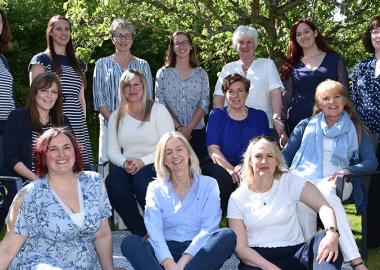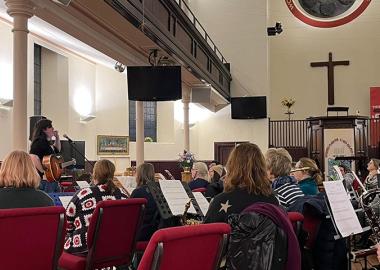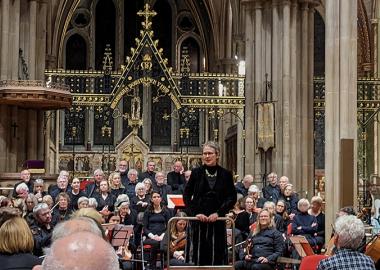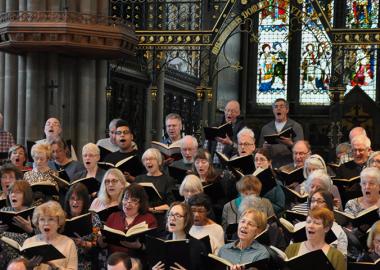Conducting; standing at the front waving your hands trying to control the music, without actually making any noise, is a strange activity. Although the reality of conducting is far more subtle, you are really nothing more than a glorified traffic cop signalling when to ‘go’, ‘stop’, and controlling the speed of the traffic.
I conduct Spectrum Singers who this year premiered Rosie Clements’ piece In Reginald’s Garden as part of Making Music’s Adopt a Composer scheme. I always try to challenge the individual members of the chorus to take on creative responsibility by being aware of each other, of the acoustic and of where their part fits in. This means the choir respond to each other live in concert, taking direct control of their lines in the music. When this works well, I give minimal input as a musical traffic cop; in fact, I like nothing better, carefully, than to lose control!
In Reginald’s Garden – the name of which is taken from the grounds of the house where the piece was premiered (Dyffryn House in the Vale of Glamorgan) – took the concept of losing control to the furthest level. Rosie challenged us by introducing the choir to ‘chance music’. Throughout the expansive opening, each performer is asked to start and, at a moment of their own choosing, to repeat a unique sentence – each of which describes a growing plant. To be blunt, nobody – not even the composer – has a clue quite what will happen at this point, as the piece develops along its own path.

In our early rehearsals I must admit trying the new ‘chance’ way of making music was difficult. When you don’t have ‘right’ or ‘wrong’ notes firmly written in a score, it can be hard for the performers to know when they are doing the music justice, and it took a while for us to feel comfortable with this concept.
I was reminded of school PE lessons where our teacher would yell intimidating instructions at us to ‘run into a space’ (I think the idea was to stop us getting tackled by the opposition but I was never very good at sport!).
But as we grew to understand the music, the feeling developed that we were parts of a developing conversation, and that to sing within a space was our only means of control we could contribute as part of the team; our choir. At some indeterminate point, ‘chance music’, and the prospect of doing something ‘wrong’ no longer spooked us. As a conductor, I was able to relinquish control entirely to the singers with total confidence that the ensuing music could fulfil the composer’s vision as I understood it.
Rosie’s piece is a wonderfully descriptive portrayal of a garden growing and blossoming. Each singer starts with different text fragments, spoken or sung, as we walk from positions located around the audience to the front, putting the audience at the centre of a living, breathing, choral flowerbed and giving a very immediate and living impression of growth through sound fragments, each describing a growing plant. Each singer listens to the other voices to contribute to a quickly evolving sound world which is different each time a performance takes place. They individually judge how best to make their own contribution count, and how to make the choir work as a musical whole.
This, perhaps, is musicianship at its finest.
The piece is in three main sections. In the opening section, singers sing or speak a different sentence – each describing a growing plant – while moving around the audience. The choral flowerbed is created using the principle of ‘chance music’, although a carefully crafted set of rules keeps the choral flowerbed in check. After this exposition, a fully scored middle section is in turn evocatively spooky, sparsely beautiful and lusciously harmonious, using drone effects, spoken text and broad gaps in the texture. It is amazingly powerful to have a group of voices crying out in unison followed by pin-drop silence in a large, reverberant hall. The biggest difficulty for the choir was learning to jump at high velocity between spoken and sung text! When working with our recording engineer, we learned that if you want to be heard speaking you have to put in more diaphragm support than you would imagine; to be able to do this, our singers had to work like virtuosi!
The final section is a somewhat transcendent ending. Having toyed with our perceptions of what choral music actually is, Rosie moves towards Spectrum Singers’ traditional strengths, with a fitting, and glorious portrayal of a garden in full bloom and a dose of choral grandeur – all of which is superseded by one dramatic final musical twist. Cathedral-style block chords oscillate with weighted regularity while echoes within the choir lend distance. This is offset by two bars between the voices lending a haze to the overall perspective, setting up Rosie’s emphatic, unexpected change of key at a crucial moment to give awe and grandeur before the ending.

We wouldn’t hesitate to recommend to other groups and composers that composers and musicians alike apply to Adopt a Composer. It sets up a great place to collaborate and to experiment with musical trust. At the final key change I have just described, I feel a sense that the sun has broken through the clouds. I wonder if this is what Rosie intended. I must admit, I’ve never asked. The great thing about creating music is that it evokes a reaction, and in writing a new piece for a scheme like this, a composer places an awful lot of trust in the musicians, hoping their piece is received well, but ultimately relinquishing control. We were delighted to have an audience that was both appreciative and enthusiastic about the inspired music we had written for us by Rosie.
Find out more about the Adopt a Composer Project and listen to recordings from previous years' pieces.










